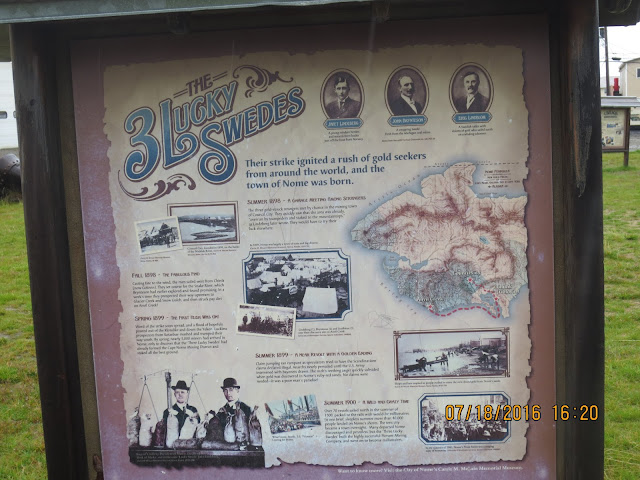July 25, 2016
Day 73
Copper Center, AK to McCarthy, AK and Kennicott Mines
Took a tour today in a van up the mountain to the town of McCarthy and the Kennicott Copper mine with Ryder, which was awesome since I was going to be on the go for almost 12 hours.
But as has been the case here in Alaska it was raining. Ryder has been getting good use out of Maryanne's raincoat!
The copper mine was founded by the J P Morgan and Guggenheim empires in New York back in the early 1900s and ran until about 1938, when most of the copper had been extracted from the 4 mines in the mountain. They pulled about $10,000,000 (billions in today's dollar) in copper from the mines and had about 6000 employees.
In order to get the copper back to a smelting company in Tacoma, Washington, they needed to build a railroad for a couple hundred miles, about 30% of which was built on tressels. They also used steamships, which they would use part of the way and then dis-assemble the ships and carry them over a mountain and re-assemble them on the other side.
Overnight in 1938, the company decided to stop mining and announced that the last train off the mountain would be at 4:00 pm that day. The mining camp was abandoned and many years later, fully furnished rooms with dinner dishes on the table, etc. were discovered illustrating the haste in which the miners departed. It became a ghost town overnight.
In 1989, Kennicott Mining Camp was placed on the National Historic Register and in 1998, the Guggenheim and J P Morgan families donated the camp and surrounding lands to the National Park Service. The Park Service now operates as a tourist site.
McCarthy, AK is 5 miles down the road from the Kennicott Mines. It was built back in the mining days, although the land was privately owned, not like the "company camp". Today, about 20 people live in McCarthy year-round. Close to 150 live in the area during in the summer.
McCarthy became infamous in 1983 when an unemployed computer programmer murdered 6 of the 22 residents of this village. Louis D. Hastings, 39 years old, in addition to being charged with 6 counts of murder, was also charged with 1 count of attempted murder and 1 count of assault in the 1st degree.
The drive to Kennicott and McCarthy was about 70 miles each way from the campground at Copper Center. The road was mostly gravel and slightly more than the width of two cars, not counting the rear view mirrors sticking out. It was about 3 1/2 to 4 hours up and 3 1/2 hours back and rained most of the day.
When we got off the shuttle at McCarthy, we had to walk in the rain and mud for about 3/4 mile. Ryder immediately went swimming in a pothole (her depth perception is a little off having only one eye) when she misjudged the depth of the puddle....just like most toddlers, any puddle is good for jumping!
To say the least, she got cold in the 42 degree rain. So, I ended up taking off my sweatshirt, wrapping her up in it and putting her in my backpack.
Thank goodness I had my raincoat!
The buildings were interesting, old, and clearly neglected for most of the past century. The National Park Service has begun trying to restore a couple of them.
When I got back to the RV, it became a spa night for the little girl...
 |
| She really doesn't look happy about having to have a bath after her excursion today.... |
.
 |
| Fish wheels in the water along the road to McCarthy, AK |
 |
| Kennicott Mine |
 |
| This used to be a tunnel but it fell down along the road to McCarthy, AK |
 |
| Garlic Fries! |

























































